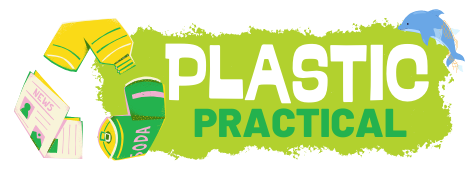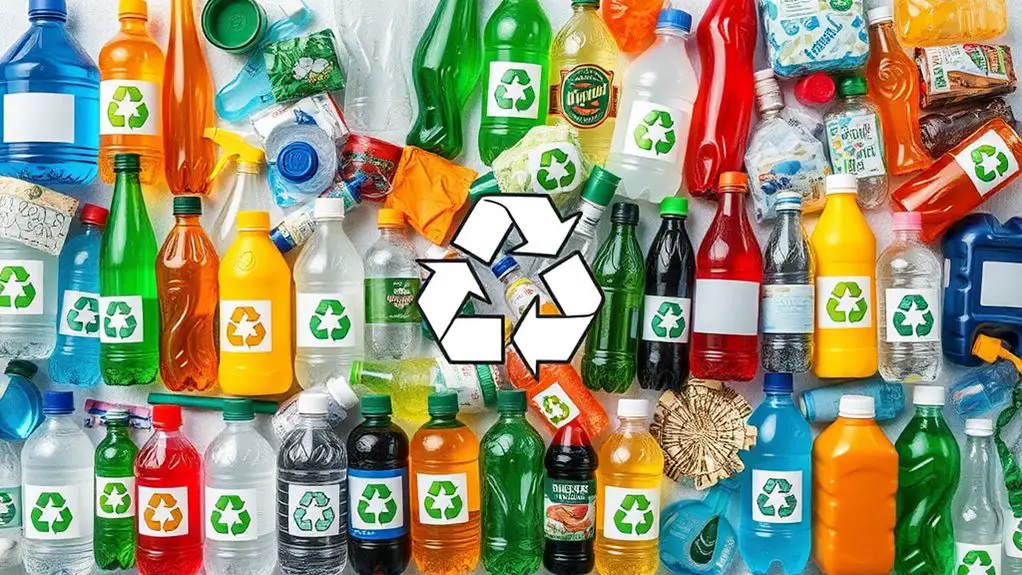When it comes to recycling, knowing the plastic codes is super helpful! You've got seven codes to watch for: Code 1 is for those handy water bottles, Code 2 is for milk jugs, and Code 3 is for stuff like pipes (but skip recycling this one!). Code 4 covers grocery bags, Code 5 is for food containers, while Codes 6 and 7 include things like Styrofoam and mixed plastics, which can be tricky. Each code means something different for recycling, so knowing them helps keep things clean. Stick around, and you'll find out even more about what each code means!
Key Takeaways
- Code 1 (PETE): Commonly used for beverage bottles; widely accepted in curbside recycling programs.
- Code 2 (HDPE): Found in milk jugs; strong and generally accepted for recycling.
- Code 3 (PVC): Used in pipes; difficult to recycle and should be avoided in curbside bins.
- Code 4 (LDPE): Includes soft plastics like grocery bags; has limited recycling options.
- Code 5 (PP): Common in food containers; gaining acceptance in recycling, but check local guidelines.
Overview of Plastic Recycling Codes
Have you ever wondered what those little numbers on the bottom of your plastic containers mean? Those numbers are actually plastic recycling codes, created by the Society of the Plastics Industry back in 1988.
There are seven distinct codes, each representing different types of plastic with unique properties and recycling characteristics. Knowing these codes helps you identify which plastics are recyclable, making it easier to do your part for the environment.
Understanding that only 5-6% of plastics are recycled in the U.S. highlights the importance of effective recycling practices and proper waste management. When you toss a plastic container into the recycling bin, understanding these codes can really make a difference. It reduces contamination in recycling streams and helps recycling facilities do their job more efficiently.
With the rise of single stream recycling, sorting processes have evolved; now, advanced technologies like robots and AI are used in Material Recovery Facilities to enhance efficiency.
As a consumer, being aware of these Plastic Recycling Symbols can influence your proper waste management practices.
Detailed Breakdown of Each Code
Understanding the plastic recycling codes can really help you make informed choices about what to recycle.
These codes, introduced by the Society of the Plastics Industry, categorize different types of plastic from 1 to 7. It's important to note that plastic bags, often categorized under complexity in assessing their environmental impact, can complicate recycling efforts.
Here's a quick breakdown:
- Code 1 (PETE): You'll find this in beverage bottles and jars, and it's super popular in curbside recycling.
- Code 2 (HDPE): Think milk jugs and detergent bottles. These are strong and usually accepted in most recycling programs.
- Code 3 (PVC): Used in pipes and siding, but it's a tough cookie to recycle. Best to avoid putting these in your recycling bin.
Codes 4 (LDPE) and 5 (PP) cover those soft plastics like grocery bags and food containers.
While LDPE has limited options, PP is gaining traction in recycling facilities, but you should check locally.
Recycling Process and Consumer Roles
How can you make a difference in the recycling process? It starts with you! As a consumer, your role is super important. When you toss plastics into your curbside recycling bin, make sure they're accepted in curbside recycling by your local municipality. Contamination can spoil an entire batch and send it straight to the landfill!
Here's a quick look at some common plastics and what you should do:
| Plastic Type | Accepted in Curbside Recycling? | Example Uses |
|---|---|---|
| PET (1) | Yes | Water bottles |
| HDPE (2) | Yes | Milk jugs |
| PVC (3) | No | Pipes |
| LDPE (4) | Sometimes | Grocery bags |
Knowing the different types of plastic helps you recycle right. Plus, community involvement in local recycling programs can boost recycling rates and reduce waste. So, get informed about your local guidelines, join recycling initiatives, and encourage your friends and family to do the same. Together, we can create a cleaner planet!
Health and Safety Concerns
When it comes to plastic, you mightn't realize just how much the type you choose can affect your health. Different recycling codes indicate varying levels of safety, especially when it comes to food storage. Here are some key health risks to keep in mind:
- Chemical Leaching: Plastics like PVC (#3) and polycarbonate (#7) can leach harmful chemicals like BPA and phthalates, which are linked to serious health issues. In fact, bottles with recycling code 7 may contain BPA and other harmful substances, making them particularly concerning for vulnerable populations.
- Temperature Sensitivity: Containers made from polypropylene (#5) can release harmful substances when heated, raising safety concerns about reheating food in them. High temperatures can cause leaching.
- Neurotoxic Effects: Polystyrene (#6) is known for leaching styrene, especially with hot foods, which can have neurotoxic and carcinogenic effects.
Being aware of these health implications is crucial. If you're storing food or beverages, consider opting for safer alternatives like glass or stainless steel.
These materials don't have the same chemical leaching risks, so you can enjoy your meals without worrying about prolonged exposure to harmful substances. Always check those recycling codes and prioritize your health!
Environmental Impact of Recycling
Choosing the right type of plastic can not only impact your health but also play a significant role in the environment. Recycling plastics has some serious environmental benefits that we can't ignore. With only 9% of plastic produced since the 1950s being recycled, it's clear we need to step up our game. When you recycle, you're helping to conserve natural resources and reduce landfill waste. For instance, recycling one ton of plastic saves about 7.4 cubic yards of landfill space.
Here's a quick look at some key benefits:
| Benefit | Impact |
|---|---|
| Conserve Natural Resources | Reduces need for new materials |
| Lower Greenhouse Gas Emissions | Cuts emissions by 1.5 tons of CO2/ton |
| Energy Conservation | Uses 66% less energy than virgin plastics |
| Fight Plastic Pollution | Helps tackle microplastics in products |
Frequently Asked Questions
What Are the 7 Plastic Codes?
Imagine sorting your laundry into different piles—whites, colors, delicates. The seven plastic recycling codes work kinda like that!
You've got Code 1 for those trusty beverage bottles, Code 2 for milk jugs, and Code 3 for pipes that rarely get recycled.
Then there's Code 4 for grocery bags, Code 5 for yogurt containers, and Codes 6 and 7 for tricky plastics.
Knowing these codes helps you recycle smarter and reduce waste!
What Do the Numbers on Plastic Recycling Mean?
The numbers on plastic recycling codes help you understand what type of plastic you're dealing with.
Each number, from 1 to 7, represents a different kind of resin, which impacts how recyclable the item is. For example, if you see a 1, it usually means it's a beverage bottle that's easy to recycle.
On the other hand, a 3 might be tricky since it's often not accepted at recycling facilities.
Which Plastic Code Cannot Be Recycled?
When you're sorting your plastics, keep an eye out for code 3, which stands for Polyvinyl Chloride (PVC).
It's tough to recycle because of its melting properties and harmful additives.
Then there's code 6, Polystyrene (PS), which is tricky too—technically recyclable, but most places won't take it.
Lastly, code 7 covers a bunch of different plastics, many of which just can't be recycled.
How Many Recycling Codes Are There?
There are seven recycling codes for plastics, and each one helps you figure out what type of plastic you're dealing with.
You'll often see these codes inside a triangle of arrows. It's like a secret language for recyclables!
For example, Code 1 is pretty common and easy to recycle, while others can be a bit tricky.
Knowing these codes can definitely help you make better recycling choices in your daily life!

